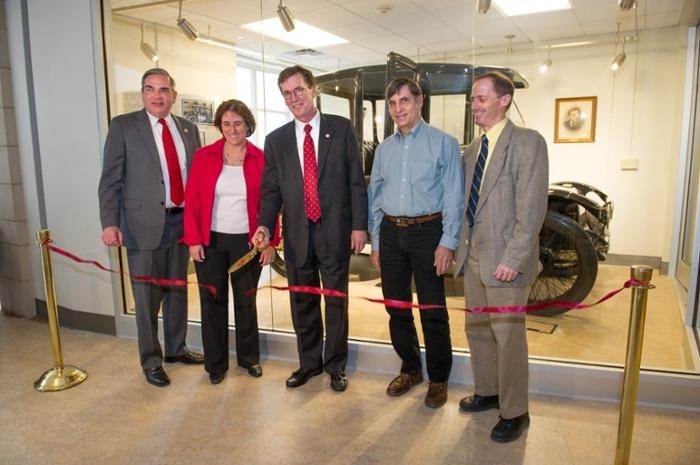When he wasn’t busy making major contributions in the field of alternating current systems, Charles Proteus Steinmetz, the great electrical engineer and inventor, liked to get around in a top-of-the-line 1914 “Duplex Drive Brougham” Detroit Electric automobile.
Although he stood just over 4 feet because of dwarfism and other physical deformities, Steinmetz cut quite a large figure in the all-aluminum vehicle with a top speed of 25 mph. Driven with a tiller rather than a steering wheel, the car runs on 14, six-volt batteries. It can drive approximately 30 miles on one battery charge.
Found rotting in a Glenville field 40 years after Steinmetz’s death in 1923, the car was purchased by the College in 1971. For the next 10 years, it was painstakingly restored by Union faculty and engineering students.
Used sparingly for campus ceremonies, the vehicle has been on display at a number of places, including the Saratoga Auto Museum and the Edison Tech Center. Mostly, it has been stored in off-campus garages.
To help celebrate Steinmetz’s 149th birthday, the College Wednesday christened the car’s new permanent display in the first-floor corridor between the Wold Center and F.W. Olin building.
“Until today, it never had a permanent home on campus where it could be appreciated,” said John Spinelli, the Horace E. Dodge III Professor of Electrical and Computer Engineering and host of the ceremony. Spinelli and driver Gene E. Davison, a lab manager in Electrical and Computer Engineering, are two of the car’s biggest champions.
Steinmetz taught electrical engineering and applied physics at Union. He was also chief consulting engineer for the General Electric Company. Steinmetz became so enamored with electric vehicles that he founded the Steinmetz Electric Car Co. in 1917.
Referring to Steinmetz as a remarkable figure in the College’s history, President Stephen C. Ainlay said one of the nation’s leading electrical engineers should remind people of the DNA of Union.
“That DNA is the notion of audacity,” said Ainlay. “The audacity to imagine what’s possible. To imagine the future in ways that benefits so many people. Steinmetz had a remarkable ability to change the world.”
The ceremony also featured the Camerata Singers, under the direction of John Cox, leading the audience, which included Schenectady Mayor Gary McCarthy and a representative of GE, in a spirited version of “Happy Birthday” to the man who held over 200 patents.
And in an ode to Steinmetz’s penchant for throwing one back and enjoying a Blackstone panatela cigar, the musical group performed “Ale and Tobacco" by Thomas Ravenscroft, published in 1614.
“I doubt that a car has ever been serenaded quite that way before,” Spinelli said.
